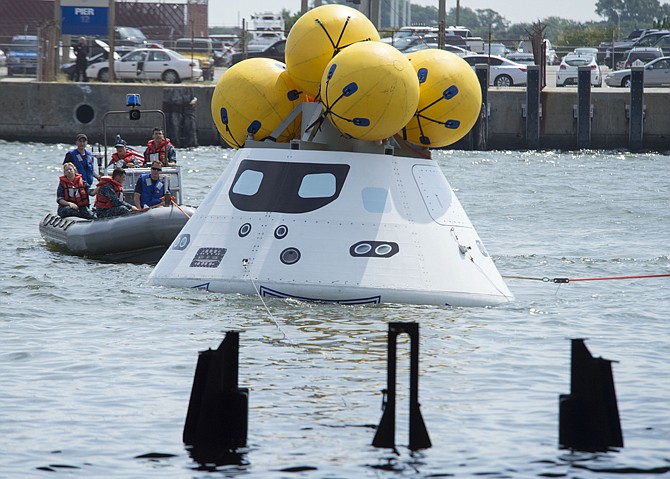NORFOLK, Va. (AP) - During the glory days of the U.S. space program in the 1960s and "70s, astronauts returning to Earth splashed down at sea in their capsules and were picked up by the Navy in a triumphant moment that made for stirring TV. Now, NASA and the Navy are training again for the first such recovery in more than a generation.
On Thursday, they completed several days of tests, practicing the retrieval of an unmanned mock-up of the Orion capsule that the U.S. hopes to send someday to an asteroid and Mars.
Navy divers and the crew of the USS Arlington carried out the exercise in the calm waters of the Elizabeth River at a Naval Station Norfolk pier.
In a statement, Adm. Bill Gortney, commander of Navy's U.S. Fleet Forces Command, welcomed the chance to take part again in recovering NASA astronauts "just as we did nearly a half-century ago in support of America's quest to put a man on the moon."
From 1961 to 1975, teams of Navy ships tracked and recovered Mercury, Gemini and Apollo spacecraft after they re-entered Earth's atmosphere and splashed down.
Typically, frogmen would swim up to the pitching, bobbing spacecraft and help the astronauts out. Then helicopters would hoist the men and their capsule and fly them to a waiting aircraft carrier. In a few instances, the astronauts would remain inside the capsule while a crane lifted it aboard a ship.
After Apollo ended, U.S. astronauts began flying the space shuttle, which returns to Earth on a landing strip like an airplane. With the end of that program in 2011, astronauts began hitching rides aboard Russia's Soyuz capsule, which parachutes to a landing on the steppes of Kazakhstan.
Now, with Orion still under development, the Defense Department and NASA have to dust off their old recovery playbook and update it to achieve something they haven't done since 1975.
"The test we're seeing today is really the first time that we've worked together with DOD to recover a capsule, really since that mission. So it's a pretty historic start to this program that we're doing," said Scott Wilson, NASA's manager of production operations for the Orion program.
In a break with the past, the Navy doesn't plan to use helicopters to retrieve Orion, although they will be available on standby. Instead, an amphibious transport ship will come close to the capsule and dispatch divers and small boat teams to go secure it.
As they did on Thursday, those crews will attach a winch line to Orion and tow it into the amphibious ship's well deck, a compartment that can be deliberately flooded. Then the well deck will be drained, allowing the astronauts to step out of the capsule.
NASA decided to employ an amphibious ship about seven years ago, in part because it is less expensive than using a large nuclear-powered aircraft carrier. It also allows for astronauts who may be weakened by space travel to avoid a physically draining extraction at sea. The crew can stay inside the capsule while it is being recovered.
More training and testing of the procedure are planned in the coming years. Astronauts will not fly into space aboard Orion until 2021 at the earliest.

